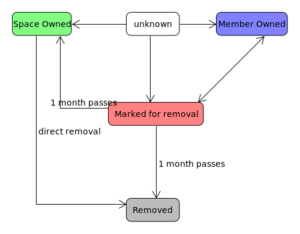Difference between revisions of "Space-labeling-draft"
(added diagram) |
|||
| Line 1: | Line 1: | ||
| + | = Justa = | ||
== What == | == What == | ||
The hackerspace has become more and more full with tools, gear, projects over the years. Some of this is a good thing, but it presents challenges. Ownership of items is sometimes unclear, as well as the status of the item in the space. Is it inventory ? Is it maintained ? Is it donated 'junk' that can be re-purposed ? Is a new tool that appears in the dirty room in a functional state at all, or did someone leave it there in the hope that 'someone' will fix it ? | The hackerspace has become more and more full with tools, gear, projects over the years. Some of this is a good thing, but it presents challenges. Ownership of items is sometimes unclear, as well as the status of the item in the space. Is it inventory ? Is it maintained ? Is it donated 'junk' that can be re-purposed ? Is a new tool that appears in the dirty room in a functional state at all, or did someone leave it there in the hope that 'someone' will fix it ? | ||
| Line 46: | Line 47: | ||
The scheme's description does not list | The scheme's description does not list | ||
| + | = Gorgobal = | ||
== Proposal 2 == | == Proposal 2 == | ||
Revision as of 19:35, 19 September 2021
Contents
Justa
What
The hackerspace has become more and more full with tools, gear, projects over the years. Some of this is a good thing, but it presents challenges. Ownership of items is sometimes unclear, as well as the status of the item in the space. Is it inventory ? Is it maintained ? Is it donated 'junk' that can be re-purposed ? Is a new tool that appears in the dirty room in a functional state at all, or did someone leave it there in the hope that 'someone' will fix it ?
Since ownership and status is unclear, nobody is really feeling entitled to take ownership of the situation when they find something 'abandoned', or just broken. What to do ? Who to inform ?
A system is proposed here to address some of these issues through interaction between labelling, processes, documentation.
Goals
The design goals of the proposal outlined below are the following:
- When you find an item, it should be clear 'what it is'. Where 'what' includes:
- Ownership (Space-owned ? PRivate ? Who ?)
- Status (inventory, private project, donated hackable-stuff, etc)
- Usability (functional ? Broken ? Dangerous ?)
- It should be possible, through following a process, to find a way to get rid of (unwanted/broken) items
- It should be transparent just how the procedure works, before, during and after its application
- It should give enough time for owners/involved-parties to come forward
- It should be easy and inviting to apply parts of the process to encourage its adoption
- Labeling/adding should be almost 'free' in terms of labor involved.
- Unlabeled, un-identifiable things should carry a 'penalty' in some form, giving an incentive
- Any 'identification'-scheme (labels, writing, qr-code, rfid, whatever) should allow for integration to other processes/tools.
- Allows for re-use of data, cross-linking.
Design
A proposed design to enable all of the above design-goals is listed here.
In short:
- Items are assumed to be labeled by default
- Unlabeled items will enter a process with identification and labeling as the end-goal
- It should be possible for any member to start this process, either directly or indirectly
- The process should be 'trackable', preferably on a mailinglist.
Method:
Another hackerspace (forgot name/link), has a system where they use colored labels as 'parking tickets'.
- Green: Item is 'approved' for staying. Has a reference and end-date listed
- Orange: Item is defective/broken. It serves as warning
- Blue: Item is un-identified at current.. People are requested to come forward and help get it identified
- Red: Item is marked for removal
The scheme's description does not list
Gorgobal
Proposal 2
Items can have several states in the space, indicated by different colored labels. This proposal differs from proposal 1 in that it differentiates between space and member owned objects.
Space-owned
Means that this object is property of the space. Ideally this means some instructions or information of the object can be found on the wiki. This also means that the board, maintenance committee, or anyone they appoint to do so can throw this object out without delay.
Donated objects automatically become property of the space.
Space property will be marked with a GREEN tag.
Member-owned
Property of a member should be marked as such. If a object is marked for removal, the relevant space-member will be contacted. This category includes loaned objects. A Blue tag should contain the nickname of the member.
Member property will be marked with a BLUE tag.
Marked for removal
The space maintenance committee or the board can tag a object for removal. Objects marked for removal will be marked with a RED tag. A picture of the object will be placed on the wiki, and a mail will be send to @members . Objects marked for removal get a 1 month grace period. This is when members can ask if the object can stay. This is when a object can be marked to become either member- or space-property.
After the 1 month grace period, the object either becomes property of the space, or will be removed.
Ownership unclear
When ownership is unclear, it will be marked for removal. If no one claims the object, it can become space-owned or it will be thrown away.
In the future, these tags can include a link to the wiki with documentation on the object.
